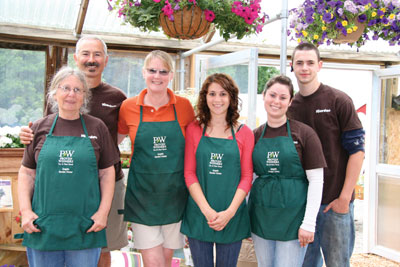
Features
Business
Retail
Breaking Down Barriers – Selling Strategies
September 28, 2011 By Judy Sharpton
In the first four instalments of this five-part series based on the
Proven Winners Store-Within-A-Store program, weve focused on several
elements of non-personal selling. We’ve looked at the impact of growing
and selling in the same space.
In the first four instalments of this five-part series based on the Proven Winners Store-Within-A-Store program, weve focused on several elements of non-personal selling. We’ve looked at the impact of growing and selling in the same space. We’ve worked around “obstructures” that can creep into a retail space over time and ways to eliminate or mitigate those barriers. We’ve discussed non-personal selling techniques like adjacencies, colour merchandising and streetside marketing. You now know what a “Do You Need?’ program can do at the cash wrap.
 |
|
| Suited up and trained to sell, Angel’s Garden Center in Hopkinton, Mass., presents a confident face to customers. The store saw a 51 per cent increase in sales of Proven Winners products in 2010 and they were a Proven Winners Destination Contest Winner in 2010. Left to right, Gail Clifford, Jeffrey Doherty, Dayle Pauli-Doherty, Julie D’Onofrio, Alexandra Doherty and Evan Tetrault. Advertisement
|
All these elements are one side of the marketing duality that makes a store work: personal selling. Simply put, non-personal selling is made up of all those silent sellers that help the customer shop the store and make a buying decision, from an aisle that will accommodate passing carts without a butt brush to an adjacency that puts a pot, a collection of four-inch annuals, potting soil and fertilizer together for a higher average sale, to POP that focuses customer attention to “Do You Need?” products arranged conveniently at the cash register.
The other, and perhaps even more interesting, side of this dual marketing model, is personal selling: all those interactions, intended and unintended, that make up the immediate relationship between the customer and the staff. That relationship may begin even before the customer enters the parking lot, with a phone conversation. Distance personal selling can mean the difference between the customer actually coming to the store and the customer not bothering.
So what is personal selling and when do you know you’re doing it right? Personal selling is first and foremost a competitive sport: a good salesperson likes to sell something to someone. That doesn’t mean the salesperson tries to mislead the customer; a competitor always wants a fair match and the opportunity for a rematch. Failing to satisfy the customer will almost surely end the relationship. The event that occurs between a salesperson and a customer is fundamentally a negotiation for the customer’s money. The word “negotiation” has come to be associated with desperate situations; the original dictionary meaning of the word, however, is “to create comfort and confidence.” That’s just what a good salesperson does: establishes a comfort level with the customer that can then open the door to building a confidence about using the product that can lead to a selling relationship.
So if selling is an act of creating customer comfort and confidence, how is that accomplished?
Most importantly, product knowledge creates confidence on the part of the salesperson to engage the customer. A core element of the Proven Winners iGarden certification program is learning about the plants. Other vendors offer or can be encouraged to provide staff training on products from fertilizers to water features. Some products are in no way self-service and require staff to know exactly what the product does in order to maintain customer confidence. Preprinted shelf talkers can assist both the staff and the customer.
Cross-training in product knowledge is critical; product knowledge cannot be the purview of an individual unless that person plans to work seven days a week. At the Apple Store, every employee is trained in every product in language the buyer can understand. If it’s possible to know the entire product line at Apple, surely it’s possible to understand annuals, perennials, shrubs and trees. If a store has a product line that is too large for staff to wrap their heads around, trim the offerings. Research in our industry consistently reminds us our customers are confused by too many choices.
Let’s go back to selling as competitive sport. All the product knowledge in the world won’t make a salesperson. In our industry, product knowledge can lead to nothing more than even greater concern for the care of the plants. Our objective is not to maintain the plants in pristine condition but to have them removed from the store by a satisfied customer. That’s how we win.
Gather your staff every week and repeat this mantra:
“My favourite plant . . .” Say it! “My favourite plant . . .”
“Is the one in the customer’s trunk!!”
Go ahead, say it out loud.
After all, a competitive team needs to cheer for its cause!
Judy Sharpton is a garden centre design and renovation specialist with 35 years of experience in advertising and promotion. She is the owner of Growing Places Marketing.
Print this page